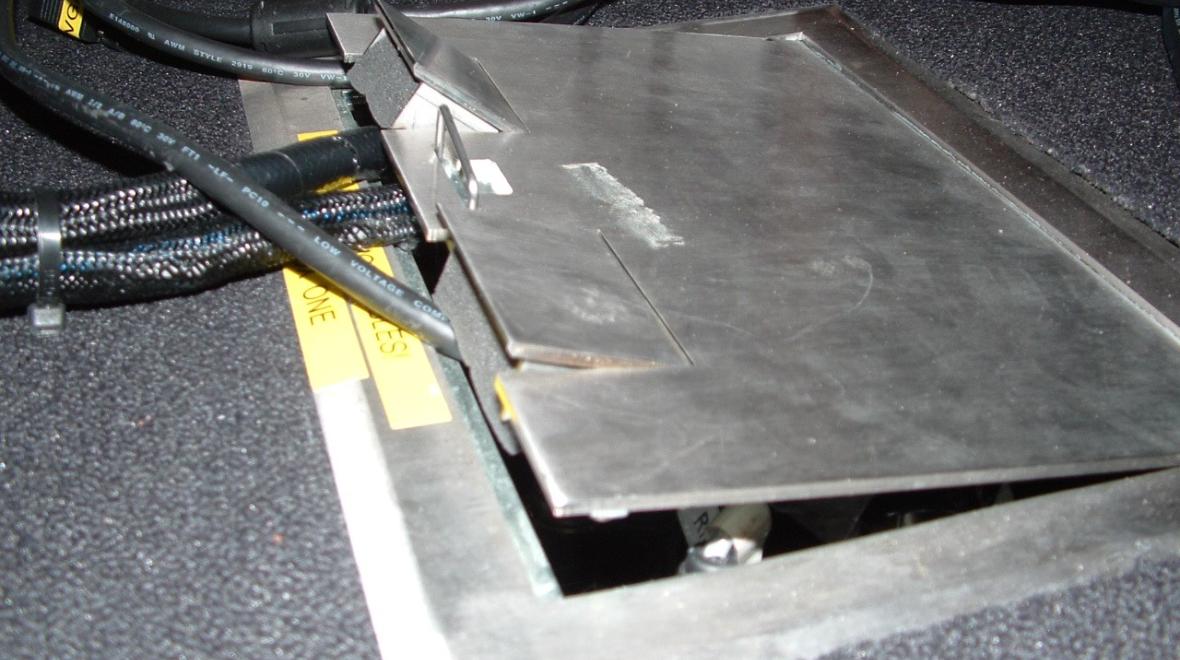Hazard alerts (2008)
Electrical & computer access floor box
This type of electrical and computer access floor box is becoming more popular in buildings at the University due to their versatility. They provide a safe and tidy below floor access for up to 6 General Purpose Outlets (GPO) as well as voice/data outlet for computer network access. Wall and ceiling mounted box designs are starting to be found, although usually only in recently constructed or recently refurbished seminar and lecture areas.
A recent electrical incident involving this type of floor box (similar to Fig 1) resulted in the lid shearing off an electrical cable and loss of electrical power.
Operationally, users of the floor box need to safely direct their electrical equipments wiring correctly through the floor box lids cable exit flaps. Guiding all associated equipment wiring out of the lid through the twin cable exit flaps, is necessary for wiring protection and to allow the lid to close flush.
To reduce the risk of repeating this incident the following safe work practices and preventative measures should be undertaken:
- ensure that all touchable metal surfaces have a reference to Earth,
- the installation of Velcro straps (as shown in Fig 2) onto the under-side of the lid adjacent to the twin cable exit flaps, to guide cabling toward the direction of the exit flaps to assist/prevent cables being trapped before closing the access lid,
- affix a label as shown in Fig 2 onto the outer edge of the housing indicating, 'Cable strap/s must be used for outgoing cables!',
- training/awareness in the safe use of the floor box and electrical equipment,
- inclusion of a floor box written instructional guideline, be provided with area access key and facilities IT usage manual,
- consider installation of floor box types constructed with a plastic lid,
- other options that may be suitable, contact the OHS Branch.
Rechargeable batteries
Rechargeable batteries are electrochemical cells in which the electrochemical reaction that releases energy is readily reversible. Some commonly used chemistries include nickel-cadmium (NiCd), nickel metal hydride (NiMH), lithium-ion (Li-ion) and lithium-polymer (LiPo).
Rechargeable batteries are used in many modern devices including mobile telephones, laptop computers, digital cameras, portable games consoles, scooters, electric wheelchairs & cycles, and scientific and other equipment.
One area for concern with the use of rechargeable batteries is the possibility for them to be overcharged.
Chargers for rechargeable batteries should utilise a continuous-current/constant-voltage (CC/CV) charging regime, and have an auto cut-off function. Where a charger does not have an auto cut-off function, it must be manually switched off to prevent overcharging of the battery. Please consult your manufacturer's documentation to determine the type of battery, charging system and the maximum time it should remain on charging.
If a rechargeable battery is overcharged, it has a risk of overheating, smouldering, fire and explosion. In the event of overcharging, the charger should be immediately isolated from its power supply. A carbon dioxide extinguisher is the best extinguisher to use on a rechargeable battery pack that is smouldering or on-fire. Water or wet agents should not be used as an extinguishing agent, as the battery may react with water or there is a risk of electrocution.
Inhalation of smoke generated in fires of this nature should be avoided, as it could be detrimental to health.
Material safety data sheets (MSDS) for rechargeable batteries are available through Chemwatch Gold or by contacting the manufacturer.
For further information email: OHS Officer
Related links
Page Owner: Human Resources

